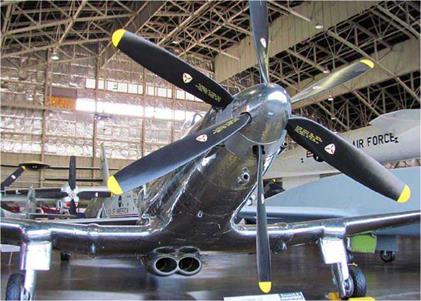Contra-rotating Propellers
Two co-axial mounted propellers driven by the same engine, but rotating in opposite directions are known as contra-props. Using two propellers mounted on the same co-axial shaft with a given propeller diameter, will absorb a greater amount of horsepower than a single prop unit. The rear-mounted propeller in the pair straightens out the helical propwash from the front propeller, which reduces the total propeller torque to zero and hence, take-off yaw and in-flight yaw caused by power changes. This is the important factor on high-powered aircraft
|
The Fisher P-75A Eagle, the last of 14 built, has a contra-prop powered by an Allison V4320 engine of 2600 BHP mounted amid-ship. It must rank as one of the earliest contra-prop aircraft to be built, (in 1943). This aircraft is displayed in the Research Section of the National Museum of the USAF, Dayton, Ohio. |
Additionally, the wing’s structural loading on multi-engine aircraft will be greatly reduced due to the absence of prop torque. On the down side, the disadvantages are the increased weight and complexity of the co-axial prop shafts. Contra – props have their own distinctive noise due to the rear prop interrupting and reacting on the helical propwash vortex formed by the front prop.
 |
Contra-props mounted on the Fairey Gannett AEW3 in
the Yorkshire Air Museum, Elvington, England.












